The cinema historian on ten south Indian films that made history
Cinema began in south India very early. The first movie Keechaka Vadham was made in Madras in 1916. South India has been most prolific as far as cinema is concerned. It is quite difficult to make a choice of ten films but I would like to say this is my choice, not necessarily the ten best films! But I feel these are films that are historic in one way or the other.
Malayalam cinema
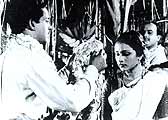 Neelakkuyil directed by P Bhaskaran:
Neelakkuyil directed by P Bhaskaran:
It was Neelakkuyil that gave Malayalam cinema a place on the national map. The story of the film was about unrequited love. It brought out the ethos and milieu of Kerala, and reflected the
distinct lifestyle of Keralites with all the characters looking like true children of the soil. The
language was another special feature as the director used the language of the common man, the Muslim dialect of
the Malabar Moplah.
Chemmeen directed by Ramu Kariat:
Chemmeen is the next landmark in Malayalam cinema. What was authentic about the film was its strong roots in the soil. It showed the true life of the fisherfolk of Kerala. It was an unusual film in the sense that it was made in colour, a rarity in 1960. It won many awards at the national level.
Before I mention my third choice, let me say in Malayalam films, the interaction between literature and cinema
was very strong. Chemmeen was based on the novel by Jnanpith Award winner Thakazhi Sivasankara Pillai. As the market this language was catering to was very small, they could not make big budget films. So, the film-makers went in for
authentic locales which turned in their favour as it lent a lot of credibility to Malayalam cinema. A very interesting development took place in Malayalam cinema in the early seventies. Many graduates from the Pune Film
Institute joined the film industry in Kerala and brought in new aesthetics to Malayalam cinema.
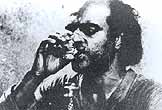 The third film I want to include is G Aravindan's Chidambaram (1985) based on a short story by
C V Sreeraman. Aravindan is one of the great film-makers of India. Chidambaram was set in a very authentic locale and had this great cinematographer Shaji N Karun assisting him. The story reached a mystical level in the
end and as typical of Aravindan -- he did not give an ending to the film but left you tantalising. It was a great
movie.
The third film I want to include is G Aravindan's Chidambaram (1985) based on a short story by
C V Sreeraman. Aravindan is one of the great film-makers of India. Chidambaram was set in a very authentic locale and had this great cinematographer Shaji N Karun assisting him. The story reached a mystical level in the
end and as typical of Aravindan -- he did not give an ending to the film but left you tantalising. It was a great
movie.
Telugu cinema
Telugu cinema started like Tamil cinema with an emphasis on mythology because drama companies were very active
here. Film-makers found it very easy to adapt the dramas. What they did was -- they placed a camera in front and
shot the drama. Soon the nationalistic wave influenced the industry and produced some very interesting films.
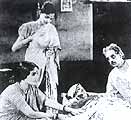 One such film was H M Reddy's Rythubidda (1939). It was about zamindarism, oppression, etc. He also touched upon Gandhian ideals, which was part of the reformist movement. For example, Rythubidda, pokes fun at Westernisation. At that time it had a lot of problems with the censors. With Rythubidda and the nationalistic flavour it had, Telugu cinema attained respectability. Unfortunately, even after Rythubidda, Telugu cinema continued concentrating on entertainment alone.
One such film was H M Reddy's Rythubidda (1939). It was about zamindarism, oppression, etc. He also touched upon Gandhian ideals, which was part of the reformist movement. For example, Rythubidda, pokes fun at Westernisation. At that time it had a lot of problems with the censors. With Rythubidda and the nationalistic flavour it had, Telugu cinema attained respectability. Unfortunately, even after Rythubidda, Telugu cinema continued concentrating on entertainment alone.
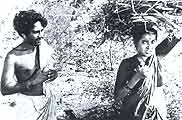 In 1977, when the Naxalite ideology became well-known in India, Mrinal Sen made a Telugu film called Ooka Ooru
Katha. The movie was about the oppression suffered by the peasants, workers, etc. Another interesting feature was that he made Gaddar, a well-known revolutionary poet and singer, sing some revolutionary songs. So, this political film is very important in the history of Telugu cinema. But political cinema and realistic cinema did not catch on in Andhra Pradesh like it did in Kerala or in Karnataka.
In 1977, when the Naxalite ideology became well-known in India, Mrinal Sen made a Telugu film called Ooka Ooru
Katha. The movie was about the oppression suffered by the peasants, workers, etc. Another interesting feature was that he made Gaddar, a well-known revolutionary poet and singer, sing some revolutionary songs. So, this political film is very important in the history of Telugu cinema. But political cinema and realistic cinema did not catch on in Andhra Pradesh like it did in Kerala or in Karnataka.
Kannada cinema
Karnataka also had to a large extent produced only mythologicals which were very popular too.
Then a group of people comprising a writer, a theatre expert and a film-maker joined together to produce a film. I am talking about U R Ananthamurthy who wrote Samskara in Kannada, Girish Karnad and Pattabhi Rama Reddy. It broke new ground and showed people how films can be used to shake your mindset and question your values. The film was in black and white and still remains a milestone in Indian cinema. Samskara started a movement in film appreciation in Karnataka and created a new sensitivity to cinema.
By this time, quite a few graduates of the Pune Film Institute came onto the scene. The Pune Film and Television Institute is a very important factor in the film scene of India. If you look at the films that have won critical acclaim outside and inside the country, you will see that many of them were made by students of the institute. I am not
saying that only they can make good films. Aravindan is a great exception.
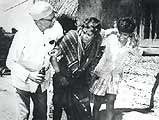 At this point I must mention one name -- Girish Kasaravalli who is a graduate from the Pune Film Institute. He has made a number of films but I want to concentrate on Tabarana Katha. Tabara is a poor man who worked in a
coffee board. After retirement he tries to get his pension which is due to him. Ultimately, he doesn't get his pension
and becomes mad. The heartlessness of the bureaucracy, the suffering of the poor, the callousness with which they are treated; all
these are very powerfully brought out and told in a very cinematic language. Like the films from Kerala, this was also rooted in
the soil. Girish Kasaravalli remains a very important film-maker in the Indian scene.
At this point I must mention one name -- Girish Kasaravalli who is a graduate from the Pune Film Institute. He has made a number of films but I want to concentrate on Tabarana Katha. Tabara is a poor man who worked in a
coffee board. After retirement he tries to get his pension which is due to him. Ultimately, he doesn't get his pension
and becomes mad. The heartlessness of the bureaucracy, the suffering of the poor, the callousness with which they are treated; all
these are very powerfully brought out and told in a very cinematic language. Like the films from Kerala, this was also rooted in
the soil. Girish Kasaravalli remains a very important film-maker in the Indian scene.
Tamil cinema
Till the seventies, Tamil film industry acted as a school for all the early film-makers. While Kannada and Malayalam cinema branched out and made their mark in the international scene, Tamil and Telugu did not do that.
Haridas was made in 1944. The lead actor was N K Thyagaraja Bhagavathar. The film created history by running continuously for one whole year in one theatre. Earlier, a commoner, a person born in a lower caste had no chance to
listen to Carnatic music but by including Carnatic music in the film, it was brought to the masses. A big barrier was broken
through this film.
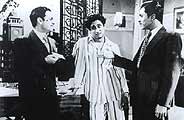 Parasakthi is a landmark film because the script written by M Karunanidhi contained a lot of reformist ideas of the Dravidian movement. It also brought great importance to the highly literary, flowery language in films. With this
film, spoken words became a very important form of the entertainment component. In fact, the dialogues of Parasakthi
were so famous that the film-makers made audio cassettes of its dialogues. Sivaji Ganesan made his debut in this
film.
Parasakthi is a landmark film because the script written by M Karunanidhi contained a lot of reformist ideas of the Dravidian movement. It also brought great importance to the highly literary, flowery language in films. With this
film, spoken words became a very important form of the entertainment component. In fact, the dialogues of Parasakthi
were so famous that the film-makers made audio cassettes of its dialogues. Sivaji Ganesan made his debut in this
film.
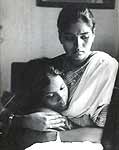 The third film that I want to mention is Balu Mahendra's Veedu. Balu Mahendra was a gold medallist from the Pune Film Institute. Veedu, made in 1996 was about the housing problem faced by urban India and how traumatic it is to construct a house. It also touched upon the insensitivity of the bureaucracy. The film is
open-ended. It does not give any solution. This is the best film by Balu Mahendra.
The third film that I want to mention is Balu Mahendra's Veedu. Balu Mahendra was a gold medallist from the Pune Film Institute. Veedu, made in 1996 was about the housing problem faced by urban India and how traumatic it is to construct a house. It also touched upon the insensitivity of the bureaucracy. The film is
open-ended. It does not give any solution. This is the best film by Balu Mahendra.
As told to Shobha Warrier
Theodore Baskaran's photograph: Sanjay Ghosh
Film stills: Courtesy Film News; Anandan
Tell us what you think of this list
